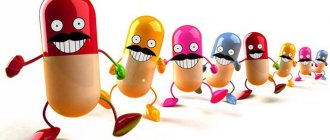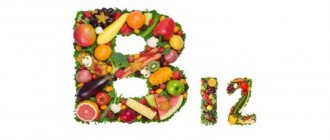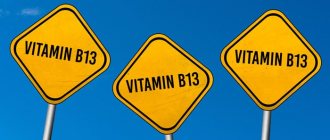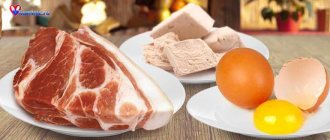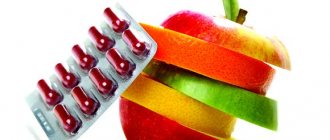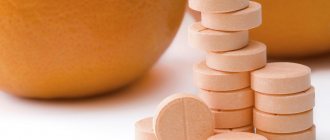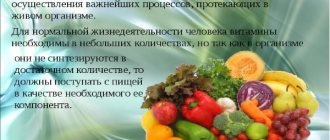The role of B vitamins for the body and immunity
B vitamins include 8 biologically active water-soluble organic compounds. Before modern research conducted at the beginning of the 21st century, they included 3 more substances (B4 - choline (carnitine), B8 - inositol, B10 - para-aminobenzoic acid).
Composition of B vitamins.
The biological role of B vitamins is determined by their chemical structure.
As coenzymes or coenzymes, they participate in the redox reactions of enzymes, metabolic processes, and the synthesis of substances (acids, peptides, neurotransmitters, adrenal hormones).
What functions do vitamins perform in all body systems?
- provide energy metabolism by absorbing biofuels and nutrients from food;
- promote the production of blood cells, hemoglobin, antibodies;
- protect the epithelium of the skin, nails, and hair from damage, desquamation, and the development of dermatological pathologies;
- regulate the saturation of tissues with oxygen, the balance of glycogen, insulin, cholesterol and their subsequent breakdown;
- improve blood movement throughout the body, which prevents vasoconstriction, blood clots, and anemia;
- stimulate the functions of the central nervous system, immune, and reproductive systems.
Foods that contain vitamin B1 - thiamine
When thiamine enters the body, it accumulates in the muscle tissue of the skeleton, brain, heart, and gastrointestinal tract.
Vitamin deficiency develops with a poor diet, alcohol or nicotine abuse, and is often accompanied by neurological disorders. The daily requirement for the substance is 1-1.2 mg.
It is found in large quantities in foods of plant origin and certain meat products.
Main food sources of thiamine (in mg per 100 g of product):
Foods high in vitamin B1.
- bread made from wheat flour - 0.18-0.23 mg;
- soybean - 0.3-0.7 mg;
- legumes (chickpeas, peas, lentils, beans) - 0.5 mg;
- sunflower seeds - 1.8 mg;
- greens (sorrel, spinach, asparagus, parsley) - 0.1-0.2 mg;
- vegetables (carrots, celery, beets, potatoes, cabbage) - 0.08-0.15 mg;
- fruits (pineapple, durian, tangerine, plum) - 0.08-0.3 mg;
- dried fruits (dried apricots, raisins) - 0.1-0.15 mg;
- offal (beef or pork liver, brain, heart) - 0.08-0.12 mg;
- nuts (hazelnuts, pistachios, cashews, peanuts) - 0.4-0.8 mg;
- yeast - 0.4 mg;
- flour (rye, wheat, buckwheat) - 0.4-0.5 mg.
Tuna
Tuna is a good source of niacin and an excellent choice for people who eat fish but not meat.
One 165-gram serving of canned tuna contains 21.9 mg of niacin—more than 100% of the RDA for men and women ().
It is also high in protein, vitamin B6, vitamin B12, selenium and omega-3 fatty acids.
There is some concern about mercury toxicity because the metal can accumulate in tuna meat. However, eating one can of canned tuna per week is considered a safe amount for most people ().
Summary:
One 165-gram can of canned tuna provides more than 100% of the RDA for niacin for both men and women, making it an excellent option for meeting this nutrient's needs.
Where is more vitamin B2 - riboflavin?
Riboflavin is not stored in the human body; excess substance is excreted through the kidneys. To prevent vitamin deficiency, it is necessary to include daily in the diet foods rich in vitamin B2 (eggs, nuts, mushrooms, meat and dairy). The required daily dose is 1.7-2.2 mg.
How much riboflavin is contained in different foods (in mg per 100 g):
Foods rich in vitamin B2.
- mushrooms (ceps, champignons, chanterelles, oyster mushrooms) - 0.5-2.5 mg;
- meat by-products (beef kidneys, liver) - 1.8-2.1 mg;
- cheeses (feta, suluguni, camembert, roquefort, cheddar) - 0.85-0.4 mg;
- milk powder - 1.8-1.3 mg;
- nuts (almonds, hazelnuts, pine) - 0.5-0.7 mg;
- eggs - 0.6 mg;
- fermented milk products (cottage cheese, yogurt, kefir) - 0.18-0.3 mg;
- fish (salmon, pink salmon, salmon, herring, herring, mackerel) - 0.15-0.25 mg.
Most cereals, pasta, vegetables and fruits contain 0.03-0.08 mg of the substance.
Ground beef
Beef is a good source of niacin and is rich in protein, iron, vitamin B12, selenium and zinc ().
Lean beef contains more niacin than the fattier cuts.
For example, one cooked 85-gram serving of 95% lean ground beef contains 6.2 mg of niacin, while the same amount of 70% lean ground beef contains only 4.1 mg (, ).
Some studies have shown that meat from grass-fed cows contains heart-healthy omega-3 fatty acids and antioxidants compared to meat from grain-fed cows ().
Summary:
Beef is a good source of niacin. Lean beef contains 1/3 more niacin than fattier cuts. Moreover, meat from naturally fed cows contains more antioxidants and omega-3s than meat from grain-fed cows.
List of products containing B3 - nicotinic acid
For digestive and cardiovascular disorders, chronic infectious diseases, hepatitis, pellagra, stress, pregnancy and breastfeeding, it is necessary to consume enough vitamin B3 (PP) with food. The content of the substance is high in mushrooms, nuts, meat, fish, seeds, and cereals.
The table lists products that cover the daily requirement (20-25 mg) of nicotinic acid.
| Name | How much vitamin PP contains (mg per 100 g) |
| Mushrooms (honey mushrooms, white mushrooms, boletus, russula) | 6.5-10.5 mg |
| Nuts (peanuts, hazelnuts, walnuts) | 5-18.5 mg |
| Seeds (sunflower, sesame, soybean) | 9.5-15 mg |
| Eggs | 3 mg |
| Meat (beef, pork, rabbit, lamb) | 6-8 mg |
| Poultry (chicken, turkey) | 12.5-13.5 mg |
| Fish (pink salmon, chum salmon, perch, herring, mackerel) | 8-11.5 mg |
| Seafood (squid, mussels, shrimp) | 4.5-7.5 mg |
| Dried fruits (dried apricots, dates, dried apples) | 1.5-2 mg |
| Fermented milk products (cheese, cottage cheese, yogurt, kefir) | 3.5-6.5 mg |
| Cereals | 2.5-5 mg |
| Legumes (beans, lentils, peas) | 6.5-8 mg |
Is excess vitamin B3 harmful?
An excess of vitamin B3 can cause no less harm to the body than its deficiency. Nicotinic acid hypervitaminosis is indicated by flushing of the face, numbness of the extremities, and constant dizziness. If the overdose of the vitamin is not very large, the symptoms are similar to ordinary allergies. But if hypervitaminosis is severe and prolonged, then serious health problems begin: malfunctions of the digestive system, liver dystrophy. A sick person experiences acute pain in the stomach, nausea, and poor appetite. The whites of the eyes and skin take on an unnatural yellowish tint.
To avoid such troubles, you should take nicotinic acid preparations only in doses prescribed by your doctor. It is prohibited to use niacin-based medicines for people suffering from ulcers, gout, hypotension, bleeding disorders, liver and thyroid diseases.
What does vitamin B4 contain - choline?
Treatment of pathologies of the liver, nervous and cardiovascular systems is accompanied by the administration of choline.
This vitamin-like substance enters the body from food or vitamin supplements, then, under the action of enzymes, it is broken down and promotes the metabolism of carbohydrates, lipids, and prevents the accumulation of adipose tissue in organs.
The daily intake of vitamin B4 is 500 mg. A sufficient amount of the substance is found in food:
Foods high in choline (vitamin B4).
- eggs - 250-500 mg;
- egg yolk - 750 mg;
- soybean - 280 mg;
- poultry (turkey, chicken) - 120-140 mg;
- fermented milk products (sour cream, cream, kefir, cottage cheese) - 40-120 mg;
- fish (pink salmon, herring) - 65-95 mg;
- cereals (oatmeal, wheat, rice) - 85-95 mg;
- pasta - 53 mg;
- flour - 75-85 mg;
- milk powder - 110 mg;
- meat (beef, lamb, pork) - 75-90 mg;
- nuts (peanuts, almonds, pine nuts) - 53 mg.
What is the daily intake of vitamin B3?
Since a person gets vitamin B3 mainly from food, the daily diet should be balanced. It is important that the menu includes foods rich in microelements. Infants, pregnant women and nursing mothers especially need the vitamin. Also, the need for it increases in people who constantly experience high mental, mental and physical stress, live and work in unfavorable climatic conditions, take antibiotics and undergo chemotherapy. Niacin deficiency is often observed in residents of subpolar regions, heavy industry workers, pilots, rescue workers and employees of other risk-related professions. Vegetarians and believers who observe fasts should also monitor the amount of vitamin consumed.
If there is a deficiency of a microelement, the doctor may prescribe it in pharmaceutical form. This is especially true for women carrying a fetus or breastfeeding a newborn child. What is the daily intake of vitamin B3 for different segments of the population? It amounts to:
- for infants up to six months – 24 mg;
- for infants from six months to one year – 6 mg;
- for children from one to three years – 8 mg;
- for children from three to fourteen years old – 12 mg;
- for adolescents over fourteen years of age – 16 mg;
- for adult women and men – 20 mg;
- for pregnant and nursing mothers – 25 mg.
Table of foods high in vitamin B5 - pantothene
In addition to being synthesized in the human intestine, pantothenic acid is widespread in nature and is found in many foods. Vitamin B5 deficiency is rare and manifests itself in metabolic disorders (exhaustion, depression, pain, dysfunction of all body systems). The recommended daily dose of the substance is 5-10 mg.
Vitamin B5 content in products.
The table shows a list of products containing pantothene:
| Name | How much vitamin B5 is contained (mg per 100 g) |
| Eggs | 4 mg |
| Powdered milk | 3.5 mg |
| Bran | 1.5-2 mg |
| Cereals (wheat, oats, rye, rice) | 0.6-1.2 mg |
| Fermented milk products (yogurt, kefir, milk, cream, cheese) | 0.35-0.5 mg |
| Fish (perch, herring, mackerel, salmon) | 0.6-1.5 mg |
| Flour | 0.5-0.8 mg |
| Legumes (beans, lentils, peas) | 1-2.3 mg |
| Nuts (peanuts, hazelnuts, almonds) | 0.5-1.7 mg |
| Avocado | 1.5 mg |
| Cabbage of different varieties | 0.5-0.9 mg |
| Sunflower seeds | 1.12 mg |
| Green peas | 0.85 mg |
Eggs and dairy products
Eggs are an excellent product that contains vitamin B. The yolk contains a colossal amount of B7, along with other representatives of the vitamin B group. For better absorption, you should eat raw eggs (this should be done carefully). If heat treatment cannot be avoided, then it is better to choose the method of boiling soft-boiled eggs or frying them with a runny yolk. It is enough to eat 1-2 eggs a day.
Vitamin B is also found in dairy foods. One glass of milk can provide the body with about 20% of the vitamins of this group. If milk is poorly tolerated by a person due to individual digestion processes, then fermented milk products should be chosen.
Content of vitamin B6 - pyridoxine in products
With a deficiency of pyridoxine, metabolism, hematopoiesis and immunity are inhibited. It is used in the treatment of patients with infectious diseases, pathologies of the cardiovascular and nervous systems.
The substance is common in nature, but is destroyed by heat. Therefore, the recommended daily dose (1-2 mg) is best obtained from fresh vegetables and fruits.
What foods contain vitamin B6:
- nuts (pistachio, hazelnut, cashew) - 0.5-1.7 mg;
- seeds (sesame, sunflower) - 0.8-1.3 mg;
- vegetables (avocado, cabbage, potatoes, sweet peppers) - 0.2-0.5 mg;
- garlic - 1.2 mg;
- fruits (banana, persimmon, pineapple, mango) - 0.1-0.4 mg;
- bread - 0.1-0.2 mg;
- cereals (corn, semolina, pearl barley, wheat, buckwheat, barley) - 0.17-0.52 mg;
- fatty fish - 0.55-0.8 mg;
- meat (chicken, pork, beef, turkey) - 0.31-0.5 mg.
Peanut
Peanuts are one of the best vegetarian sources of niacin.
Two tablespoons (32 grams) of peanut butter contain 4.3 mg of niacin—about 25% of the RDA for men and 30% for women ().
Peanuts are also rich in protein, monounsaturated fat, vitamin E, vitamin B6, magnesium, phosphorus and manganese ().
Although peanuts are relatively high in calories, research shows that eating them daily is associated with health benefits, such as a reduced risk of developing type 2 diabetes. In addition, daily consumption of peanuts does not lead to weight gain (, ).
Summary:
Peanuts are very rich in niacin, providing about 1/3 of the RDA for men and women when consuming just 2 tablespoons of peanut butter. It is also a good source of heart-healthy fat and many vitamins and minerals.
Vitamin B7 - Biotin
The bulk of biotin is produced in the human intestine, the remainder enters the body with food. The daily requirement for vitamin B7 is 50 mcg; a complete diet containing plant and animal products fully covers this requirement.
A deficiency of the substance is accompanied by anemia, damage to epithelial tissue, digestive disorders, and deterioration in the quality of hair, skin, and nails.
List of foods high in biotin (in mcg per 100 g):
- cooked eggs - 25 mcg;
- cereals (oatmeal, rice, wheat) - 12-20 mcg;
- chicken meat - 8.5-10 mcg;
- fermented milk products (acidophilus, kefir, cream, sour cream) - 3-3.5 mcg;
- semi-hard cheeses - 4.2-5.6 mcg;
- cottage cheese - 5-7.5 mcg;
- cod liver - 11 mcg;
- soybean - 62 mcg;
- cabbage of different varieties - 1.5-2 mcg;
- tomato - 1.3 mcg;
- onion - 0.9 mcg.
Other vegetables, fruits, and herbs contain 0.3-0.8 mcg of the substance. In meat products, fish, nuts and mushrooms - 0.1-7 mcg.
Foods rich in biotin.
About vitamin B3
There are two forms of vitamin B3:
- Nicotine type acid. It can only be found in plant products.
- Nicotinamide is a substance that can only be found in animal products.
Vitamin B3 is a water-soluble substance; after it enters the stomach, it is absorbed in a fairly short time. Its role in the formation of energy is very great. And it is a sufficient amount of niacin that allows you to maintain the required glucose level in the blood. Given the importance of this substance, it is necessary to be aware of which products contain it in the required amount.
What foods contain vitamin B8
Inositol is a vitamin-like substance that is independently formed in cells from glucose and travels with the blood to all organs. The daily requirement for vitamin B8 is 0.5-1.5 mg and is 80% covered by the body's internal reserves.
With a poor diet, heavy physical activity, frequent stress, and bad habits, the need for the substance increases.
Which foods contain inositol (in g per 100 g):
- bran (wheat, oat, rice) - 0.4-0.5 g;
- cereals (oatmeal, barley, corn) - 0.25-0.37 g;
- citrus fruits (orange, grapefruit, tangerine) - 0.15-0.25 g;
- legumes (peas, lentils, green beans) - 1.2-1.42 g;
- vegetables (cabbage, carrots, beets, tomatoes) - 0.06-0.09 g;
- fruits (peaches, bananas, apples) - 0.02-0.08 g;
- fish (flounder, salmon, sardine, cod) - 0.01-0.02 g;
- beef, beef liver - 0.02-0.05 g.
Spinach
Spinach is a plant source of vitamin B. The content in green plants is lower in percentage terms than in animal products or grains and seeds. Spinach can be called the king of greens in which vitamin B can be found. It contains a large amount of vitamin B9, consuming just 50 g of spinach can give 15% of the norm. It serves as a source of vitamins B2, B6 and B7.
Spinach is recommended to be consumed raw in salads. Sautéing for 2-4 minutes will also not remove the vitamin complex from the product.
Where is the most vitamin B9 - folic acid
Folic acid is partially synthesized by intestinal microflora; the body obtains the rest of the substance from food.
Against the background of its deficiency, anemia develops, immunity and reproductive functions weaken, and complications during pregnancy are observed.
The daily intake of vitamin B9 is 200-400 mcg, and during heat treatment during cooking, part of the substance is destroyed.
Foods rich in folic acid.
The table lists foods that contain folic acid in excess:
| Name | How much vitamin B9 is contained (mcg per 100 g) |
| Nuts, seeds (peanuts, sesame, walnuts, almonds) | 43-150 mcg |
| Soybeans | 180 mcg |
| Greens (parsley, lettuce, spinach, basil, cilantro) | 63-112 mcg |
| Avocado | 85 mcg |
| Legumes (lentils, chickpeas, beans, mung beans) | 84-95 mcg |
| Cabbage of different varieties | 62-81 mcg |
| Semi-hard cheeses | 60-67 mcg |
| Flour | 50-55 mcg |
| Fish roe | 50 mcg |
| Vegetables (corn, bell peppers, tomatoes) | 46-54 mcg |
| Cottage cheese | 42 mcg |
| Chicken yolk (cooked) | 23 mcg |
| Cream, sour cream | 10-12 mcg |
| Canned cod liver | 108 mcg |
| Fish canned in oil (sprats, sardines, sprat) | 11-23 mcg |
| Bran | 51-73 mcg |
| Bread | 30-50 mcg |
| Sunflower seeds | 221 mcg |
| Dried porcini mushrooms | 135 mcg |
Sources of vitamin B12 - cyanocobalamin
Against the background of vitamin B12 deficiency, various forms of anemia, diseases of the nervous system, and depression develop. Due to the preservation of the reserve of cyanocobalamin in the liver for 4-5 years, the pathology is rare and is mainly associated with hereditary disorders of vitamin metabolism. The required daily dosage of the vitamin is 1.8-2.8 mcg. Injection therapy or diet correction can compensate for the lack of a substance.
Food products containing vitamin B12.
List of products containing cyanocobalamin:
- meat by-products (liver, heart, stomach) - 26-60 mcg;
- seafood (octopus, mussels, shrimp) - 10-20 mcg;
- fatty fish (mackerel, herring) - 9-13 mcg;
- sea fish (perch, cod) - 0.9-1.9 mcg;
- meat (beef, lamb, chicken) - 0.8-6 mcg;
- chicken eggs - 0.9 mcg;
- fermented milk products (yogurt, cottage cheese, sour cream, cheese) - 0.4-0.7 mcg;
- tofu - 2.7 mcg.
